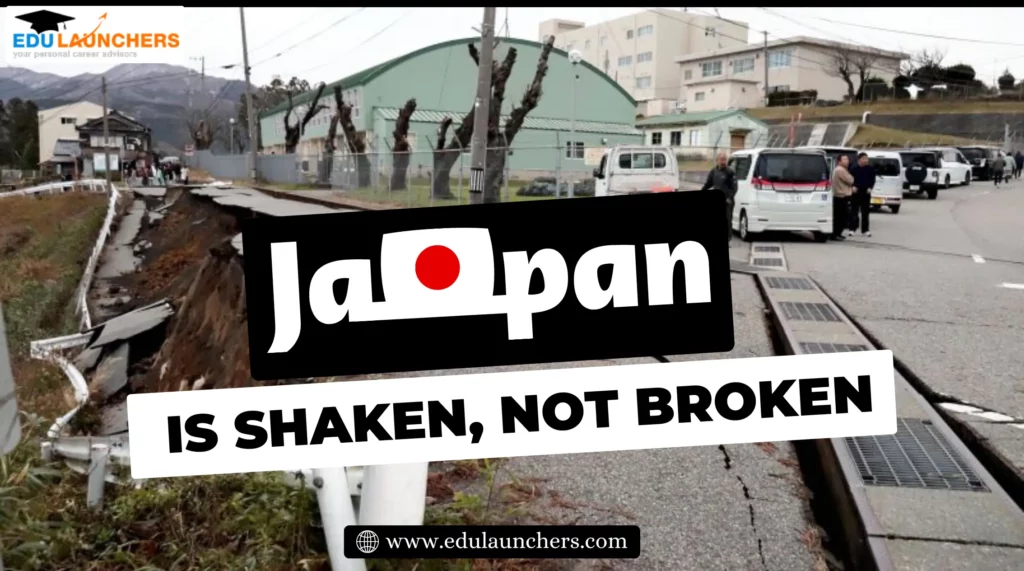As fireworks danced across the global sky, ushering in 2024, the earth beneath Japan began to tremble. Within a horrifying 90 minutes, 21 earthquakes rattled Japan, setting the stage for a day of relentless tremors – 155 in total. The disaster was followed by giant 1.2-meter tsunami wave on the western coast. Joyous cheers of celebration morphed into panicked cries.

Amid such critical situation, nations are extending help for Japan. America stands ready to provide relief aid; India is setting up emergency helplines; UK is ‘ready to help’, and other nations such as Taiwan are expressing their support through heart-felt speeches. But despite numerous nations backing Japan, the nation stands strong- with pride, facing the challenge head on. Japan’s spirit of “ganbatte”—perseverance in the face of challenges—pulsed through the nation.
Current situation in Japan:
The strong earthquake tremors that jolted nation to its bones could be felt from miles away. When Japan was still wrapping its head around such a large array of earthquakes, a giant 1.2 meter tsunami wave hit the western coast on Wajima port. The tsunami was aftermath of 7.6 magnitude earthquake which hit Wajima ten minutes prior to Tsunami.
Panic surged as the highest-level tsunami alert rang out, triggering a mass evacuation of over 100,000 people from Honshu Island. Although the tsunami warnings in the western coast have been lifted off on Tuesday morning, the tremors’ aftershocks continued to reverberate.
As of Monday evening, 97,000 people from nine prefectures on Honshu Island are moved to school auditoriums, community halls and gymnasiums. Relief teams, in conjecture with 10,000 troops, are struggling to even reach earthquake hotspots. As of Tuesday Afternoon, more than 48 people have lost their lives and several dozen are found injured.
Amid such ruckus, nations are extending help. While close ally of Japan- South Korea- prepares to embrace Tsunamis next, America and UK have expressed their intent to help Japan.
America is in thoughts with Japanese people:

President Joe Biden offered prayers and solidarity to the Japanese people in the wake of the earthquakes and tsunami.
In a statement released by the White house, President Joe Biden extended his prayers to the Japanese people, stating that ‘Japanese people are in our thoughts and prayers’. President Biden pledged US government resources to support relief efforts in Japan.
India establishes an emergency control room in Tokyo, Japan:
India, as a measure to help quake-hit Japan, has established a control room at the Indian embassy in Tokyo for tackling emergencies related to Earthquake and Tsunamis. The control room will offer disaster related information along with emergency relief to its citizens. The control room has also issued an emergency contact numbers for its citizens trapped in Japan.
UK is ready for help:

As per the press Release of UK Government, PM Rishi Sunaik stated that the situation in Japan is monitored closely, and UK is ‘ready to support’ Japan. Prime Minister Sunak conveyed the heartfelt solidarity of the UK people with Japan, highlighting close monitoring of the situation and readiness to offer any necessary support.
Undeniably, Japan is in peril. The nation is witnessing one of the worst natural disasters after the 2011 earthquake and tsunami disaster at Fukushima-Daiichi Nuclear power station. On Monday, the country issued its highest-level of tsunami warning; nearly 100000 people have been displaced from their homes. Then why are nations not extending any real help to Japan?
Japan is self-sufficient:
It is not the matter of –why nations are not helping; rather the question should be – ‘does Japan need help?’ When a disciplined nation like Japan faces such a challenge, what help can we offer? Arguably, if any nation knows how to handle earthquakes, it’s Japan, a champion in the world of disaster preparedness.

Japan has built itself the reputation of an advanced, disciplined, and self-reliant nation, which is globally known for its high quality, precision and discipline. The nation almost built itself again after World War 2; the country has completely rebuilt and reinvented the entire city after its one of the largest natural disasters of 2011- when an earthquake of 9 magnitudes was hit in Fukushima Daichii power plant- in a record time.
In the face of both war-torn devastation and devastating natural disasters, the Japanese people have repeatedly demonstrated a remarkable capacity for resilience and reconstruction.
Following World War II, Japan transformed itself into a global economic powerhouse within a few decades. This extraordinary feat was fueled by a strong sense of national pride, embodied in the spirit of “ganbatte,”and strategic government investments in infrastructure and technology.
This spirit of resilience was once again evident in the aftermath of the 2011 earthquake and tsunami. Communities united in the face of tragedy. The government responded with a comprehensive reconstruction plan, but the true strength of the recovery lay in the unwavering determination of the Japanese people.
Conclusion:
While the world offers condolences and aid to Japan, Japan stands on its own, wearing its resilience like a badge of honor. While being faced with one of the biggest natural disasters in recent decade, the nation stands strong and fights in the spirit of ganbatte. Instead of relying on foreign aid, the nation is channeling its internal fortitude.

